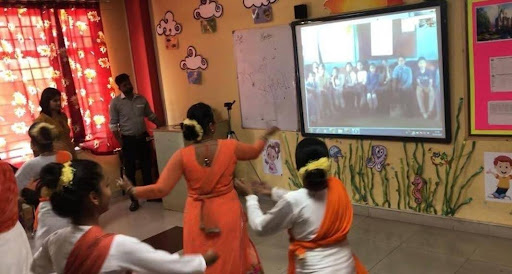
As societal shifts occur, education undergoes corresponding changes. Modern technology has changed not just how we live our everyday lives but also how classes are run, giving teachers access to a multitude of tools and resources. Modern technological development is vital in helping young people acquire and enhance cross-cultural understanding and communication skills necessary for effective day-to-day interactions in the twenty-first century (Schenker, 2013). With the use of synchronous and asynchronous modes of online resources, educators can design classrooms that closely resemble actual situations, encouraging students’ active participation. By connecting schools via platforms with synchronous modes of online learning like Skype, Zoom, Microsoft Team, Google Meet, etc., educators can connect their students with classrooms across the world to collaborate and enhance their English language skills. In this blog, I share my classroom practices of integrating technology to teach the English language and develop cross-cultural understanding by connecting my students with other students across the globe.
The Genesis of the Borderless Session

The development of information and communication technology has widened opportunities for educators and teachers to connect with the world geographically and culturally. As a result, schooling must prepare pupils for a world shaped by globalization (Darling-Hammond, 2010; Walsh, 2016). In line with this reality, I dabbled in technology throughout my early teaching career, illuminating the classroom with projectors and PowerPoint presentations. The students began to routinely sway to the beat of my digital waltz as they grew accustomed to it. However, my students grew restless as the months went by, demanding a new technology tool and a new approach to learning instead of the regular use of PowerPoint. On Friday, during an extracurricular speech competition about the effects of Facebook use, students’ desire became quite apparent. A maximum number of secondary school students used Facebook to network, learn about current events, as well as to create new acquaintances. It is evident from their speech that students found technology to be intriguing in their learning and that they also asked for more information, communication, and technology-integrated programs in schools. That speech day got me thinking about displaying fresh concepts using technology or the same projector instead of just teaching information.
When I was skimming through my Facebook, I came across a school in Punjab, India. I reached out to a teacher regarding my interest in connecting students from each other’s classrooms, opening up opportunities for them to practice their communication skills and cultural understanding. I received a response from the teacher after a week. I began brainstorming with my students and science teacher, Kumar Rumba, about possible projects. To make the session more interesting, the country name was not revealed, as they needed to guess themselves by asking yes-no questions. Students were assigned different roles as speakers, dancers, singers, etc. Some of them were anxious and hesitant to communicate with students from another country. We did not have a computer lab or a well-managed classroom but also we decided to commemorate International Dancing Day by collaborating with other teachers in our school.

On a Friday afternoon, my students dressed in traditional attire waited for a Skype call. It was a new experience for all of us, and I had mixed feelings. I was worried about my laptop’s data connection and whether the Skype call would go smoothly. We gathered in an office room with ‘Yes’, and ‘No’ cards, a flag, and a globe. We received their Skype call at noon and saw teachers seated on a beautifully decorated stage, accompanied by a dancer. At first, we played a guessing game where each student tried to guess each other’s countries through a series of yes/no questions. They were not allowed to provide any clue; they just needed to show a yes or no card. After asking a series of questions, students from Punjab guessed our country correctly, and our students displayed Nepal’s flag. Later, our students also guessed their country, and they displayed their national flag. The guessing game enhanced cognitive and communication skills in my students.
Next, our students and teachers (from my school) introduced themselves to each other. The students from Punjab greeted us in their native language, and my students did the same in Nepali. They described their country’s flag, traditional attire, and the school. When my students heard simple English sentences, their confidence level increased, and those students who hesitated to speak also actively took part in the conversation. One of my students exclaimed, “Ini haruko pani English hamro jasto raichha” (their English language is also like ours), demonstrating their confidence to communicate with their counterparts. Soon, they engaged in the conversation as if they had known each other for a long time.
Following this exchange, students took turns sharing ethnic dances. This experience fostered a sense of global community. The students who were reluctant to discuss Facebook’s influence during the speech competition jumped at the chance to express themselves via dancing, like a narrative twist. It made me think about multiple ways of engaging students to cater to their multiple intelligences. The inaugural international dance between Nepal and India unfolded through the lens of Skype. Students on both ends shared not just dance steps but stories of their cultures, peering into each other’s classrooms with curiosity.
Fueled by the spirit of connection, I embarked on a mission to virtually unite my classroom with the world. Through this project, I forged ties with international acquaintances, joined online communities, and explored the connection with other classes beyond the borders through collaboration with fellow educators. This initiative was not just about crossing borders digitally; it was crucial for nurturing listening, speaking, and cognitive skills. In this dance of learning, every step was a bridge to understanding, and every word was a note in the symphony of global education. The tale of technological integration and cultural exchange emerged as a tapestry of growth, where simplicity met depth, and every breath carried the essence of learning and unity.
Language and Cultural Exchange through Skype Video Calls
Video: My students sharing cultural dance with Vietnamese students.
When we think of a classroom, we usually think of an enclosed space with four walls devoted to teaching and learning. However, in an age where technology affects human relations, communication between language teachers and students transcends traditional classroom boundaries (Romaña, 2015). This change involves moving our daily relationships into computer communication (CMC) through email or phone calls such as WhatsApp or Skype (Romaña, 2015, p. 144). Its unique features include global connectivity via video calling and student chat options.
After having connections with more than ten countries like Vietnam, Hungary, India, Japan, Spain, Portugal, and the USA, technology and learning through it is no longer a mystery to my students. They conversed with their international student counterparts and learned about one another’s way of life. They learned about other cultures and communities, and my students also shared their customs and cultures with their global counterparts, fostering characteristics of global citizens. They taught the international students Nepali language and cultures such as Namaskar (नमस्कार), Dhanyabaad (धन्यवाद), and Sanchai (सन्चै). My students also became familiar with Sati Sri Akala (Punjabi), and HaMacTe M. (Russian) from international students. Respecting one another’s identities and cultures eliminates communication barriers and fosters greater understanding of each other. This bridges the gap between classroom content and real-world situations. The Skype sessions also helped to improve their speaking, listening, and pronunciation skills. Since my students have taken virtual international tours to different classes, Europe is not a mystery to them.
The Skype Sessions promoted my students’ speaking skills and self-assurance. They practiced speaking in a real-world situation and engaged with both native and non-native English speakers worldwide by utilizing Skype in the classroom. Additionally, this cooperative and methodical approach contributed to their cognitive skills, geographic awareness, and cultural comprehension in an engaging and dynamic environment.
Conclusion
To sum up, the borderless Skype session exemplifies how engaging students with diverse cultures worldwide facilitates cross-cultural understanding, language learning, and global connections. It offers Nepali students a remarkable opportunity to learn about other cultures while sharing their own, creating an inclusive and enriching educational experience in an interconnected world. Reflecting on my journey, technology has profoundly transformed education in my class. Platforms like Skype have fundamentally changed the way I teach and learn languages, eliminating spatial and cultural barriers. Through virtual exchanges such as Skype sessions have become an effective means of fostering cross-cultural understanding, communication, and language acquisition.
However, it’s essential to recognize the challenges and responsibilities of connecting classrooms globally. Teachers must manage cultural sensitivities, coordinate across time zones, and ensure clear communication to foster meaningful relationships. Teachers and students together need to learn about the cultural norms and expectations of the communities they are going to interact with and collaborate with. Likewise, they need to communicate in advance the plan, activities, time zone, and so on for the sessions. We also need to assign different roles to students to make them accountable for their learning and organizing sessions.
Looking forward, I am excited to explore more innovative virtual exchange programs within and outside the nation. I aim to develop new strategies to overcome technological challenges and further enhance their educational experiences by integrating technological tools.
Author: Bibas Thapa is an MPhil scholar in English Language Education at Kathmandu University. He is an English lecturer and also works as an ICT facilitator. He has connected in borderless sessions with dozens of countries, such as the USA, Brazil, Portugal, Greece, Vietnam, India etc.
References
Darling-Hammond, L. (2010). The flat world and education. New York, NY: Teachers College Press
Romaña, Y. Skype™ Conference Calls: A Way to Promote Speaking Skills in the Teaching and Learning of English. PROFILE, 17, 143 -156.
Schenker, T. (2013). The effects of a virtual exchange on students’ interest in learning about culture. Foreign Language Annals, 46(3), 491–507. http://doi.org/10.1111/ flan.12041
Walsh, L. (2016). Educating generation next: young people, teachers and schooling in transition. Houndsmill, UK: Palgrave Macmillan.